Bed Load Transport and Alternation of a Gravel-Bed River Morphology within a Vicinity of Block Ramp: Classical and Numerical Approach
Abstract
:1. Introduction
2. Research Region and Object Description
3. Methodology
3.1. Field Measurements
3.2. Calculation of Bed Load Transport
3.3. Numerical Modelling
3.3.1. Drawing the Modelling Grid, Calibration and Verification Model, and Specification of Initial Conditions
- Simulation time: 3600 s;
- Time step: 0.1 s;
- Turbulence model: mixing length model.
- The initial water table taken from the consumption curve for the simulated flow;
- River bed roughness;
- Type of bed erosion where only hydraulic structures were defined as non-erodible;
- Bed load soluble layer thickness, the value of which was defined as the largest grain in the watercourse channel;
- Particle size distribution (Figure 3):
- Upstream: flow (Qflood = 55 m3·s−1) and bed load transport (Tc = 5.7 kg·m−1·s−1) as well as inflowing sediment distribution (di < 0.030 mm—15%, di = 0.030–0.040 mm—35%, di = 0.040–0.050 mm—25%, di = 0.050–0.060 mm—15%, di > 0.060 mm—10%);
- Downstream: water table level (H = 432.60 m above sea level).
3.3.2. Model Comparison with Classical Approaches
4. Results and Discussion
4.1. Detailed Results and Discussion for Qflood
- L = 30–35 m, h = 1.07 m, V = 1.8 m·s−1, τ = 36 N·m−2;
- L = 35–55 m, h = 0.66 m, V = 2.2 m·s−1, τ = 69 N·m−2;
- L = 55–65 m, h = 0.78 m, V = 2.0 m·s−1, τ = 54 N·m−2;
- L = 65–90 m, h = 0.93 m, V = 1.9 m·s−1, τ = 48 N·m−2;
- L = 90–110 m, h = 0.70 m, V = 3.7 m·s−1, τ = 275 N·m−2—a reach with the block ramp No. 14;
- L = 110–135 m, h = 1.74 m, V = 2.5 m·s−1, τ = 60 N·m−2;
- L = 135–155 m, h = 1.43 m, V = 2.6 m·s−1, τ = 72 N·m−2;
- L = 155–180 m, h = 1.24 m, V = 2.3 m·s−1, τ = 58 N·m−2;
- L = 180–202 m, h = 1.07 m, V = 2.0 m·s−1, τ = 46 N·m−2.
| Central Profile Segment L [m] | Transport Conditions for Individual Pebbles According to Hjulström’s Diagram d [mm] 1 | Transport Conditions for Individual Pebbles According to Shields’ Diagram d [mm] 2 | Transport Conditions for Individual Pebbles According to Russian Standard ST-24-2396 d [mm] 3 | Transport Conditions According to the CCHE2D Model for Bed Load 4 | Compatibility of the CCHE2D Model with Hjulström’s Diagram 5 | Compatibility of the CCHE2D Model with Shields’ Diagram 6 | Compatibility of the CCHE2D Model with ST-24-23967 Standard 7 | |||||
|---|---|---|---|---|---|---|---|---|---|---|---|---|
| Erosion—E | Transport—T | Sedimentation—S | Transport | No Transport | Transport | No Transport | Morph Dynamic | V [m·s−1] | ||||
| 30–35 | - | 25–55 | ≥65 | ≤25 | ≥35 | ≤35 | ≥45 | S | ↑ 1.60–1.85 | none * | none * | none * |
| 35–55 | ≤25 | ≥35 | - | ≤55 | ≥65 | ≤65 | - | E | ↑ 1.85–2.20 | none | none * | yes |
| 55–65 | - | 25–65 | - | ≤45 | ≥55 | ≤55 | ≥65 | S | ↓ 2.20–1.95 | none | none | none |
| 65–90 | - | 25–55 | ≥65 | ≤45 | ≥55 | ≤45 | ≥55 | S | ↔ 1.95–1.95 | none * | none | none |
| 90–110 | 25–65 | - | - | ≤65 | - | ≤65 | - | T | - | - | - | - |
| 110–135 | ≤35 | ≥45 | - | ≤55 | ≥65 | ≤65 | - | E | ↑ 2.15–2.55 | none * | none * | yes |
| 135–155 | ≤45 | ≥55 | - | ≤65 | - | ≤65 | - | E | ↔ 2.55–2.55 | none * | none | yes |
| 155–180 | ≤25 | ≥35 | - | ≤45 | ≥55 | ≤55 | ≥65 | S | ↓ 2.55–2.10 | none | none | none |
| 180–202 | - | 25–65 | - | ≤35 | ≥45 | ≤45 | ≥55 | S | ↓ 2.10–2.00 | none | none | none |
4.2. Results and Discussion for Q1% Q10%, Q50%, and Qflood
5. Conclusions
- Using 2D modelling for bed load transport calculations or the prediction of river bed morphological processes in a stream where block ramps are constructed must be safe and sometimes needs additional analysis.
- In hydraulic engineering, designing works is worthy of using some classical approaches such as those presented here, Hjulström’s and Shields’ diagrams and/or Russian standard ST-24-2396, which are classical tools for the analysis of bed load transport. All hydraulic structure designers and hydraulic engineers are supposed to be acquainted with at least one of those approaches.
- Differences with classical approaches of Hjulström, Shields, and Russian standard ST-24-2396 and 2D modelling results might be due to uncertainty of the data, such as channel bed topography, sediment load, its composition, and bed material composition, possibly affecting the prediction accuracy of the numerical model.
- Prediction of erosion, transport and sedimentation of bed load material, and calculation of the bed load transport rate in a gravel channel by means of a single numerical model, 2D in particular, such as CCHE2D, yields results that may be incompatible with in situ observations and predictions obtained using the classical approaches of Hjulström, Shields, or Russian standard ST-24-2396. For this kind of task, the use of at least two different models is suggested, supported by thorough quality control of the reliability of simulation results by making a comparison to in situ observations of morphological changes in the stream channel. It should also be remembered that the model is a simplification of the processes observed in reality. Therefore, the results obtained from modelling will never be perfectly compatible with classical methods and with reality.
- All sediment processes occur in the analyzed reach of the river. The highest values of hydrodynamic parameters (from V = 2.7 m·s−1 to up V = 5.1 m·s−1, from τ = 250 N·m−2 to up τ = 560 N·m−2 for Q50%–Q1%, respectively) occur in the block ramp. All gravel flowing into the structure should be transported downstream, primarily through the central lowering of the slope apron. However, the amount of sediment transported by the block ramp is relatively low (from Tc = 0.3 kg·m−1·s−1 to up Tc = 5 kg·m−1·s−1) because a small amount of gravel runs to the object. Sedimentation and lack of movement dominate directly above the structure for the coarse fraction (d > 0.045 m), and only the smallest grains are transported (d < 0.045 m). Above the block ramp, in the reach of 30–65, high values of hydrodynamic parameters (from V = 2.0 m·s−1 to up V = 3.5 m·s−1, from τ = 40 N·m−2 to up τ = 150 N·m−2) erode the central gravel bar, due to which large amounts of sediment (from Tc = 1.1 kg·m−1·s−1 to up Tc = 20 kg·m−1·s−1) are eroded on the upstream side of the bar and sedimented on the downstream side. Much higher values of hydrodynamic parameters also occur downstream of the structure (from V = 2.0 m·s−1 to up V = 3.5 m·s−1, from τ = 50 N·m−2 to up τ = 100 N·m−2), where an extensive erosion of the river bed can be observed (from Tc = 0.1 kg·m−1·s−1 to up Tc = 10 kg·m−1·s−1). The farther away from the block ramp, the lower the velocities and forces (from V = 1.5 m·s−1 to up V = 3.0 m·s−1, from τ = 30 N·m−2 to up τ = 80 N·m−2, from Tc = 0 kg·m−1·s−1 to up Tc = 2.5 kg·m−1·s−1); the erosion process disappears and the transport and even sedimentation processes begin to dominate in the river. At this point, a stream of water flows out of the erosion gutter, which was formed between two side gravel bars.
- In modern river management and hydraulic structure designing works, there is still an important place for classical approaches since they form the theory for all the later developed models. Additionally, the developed models might be still improved based on the classical results. In some cases of designing works (especially when time is the issue), using the classical approaches might even be much more effective and still is advisable.
- In the future, it might be valuable to change the model into a much more detailed one where each individual block would be included. It could make calculations much more precise. However, while such change is possibly useful for scientific reasons, in the case of a practical survey in the field, it is not. This is because land surveys take a very long time. In addition, such analysis will be possible in the future when we can conduct underwater laser scanning.
Author Contributions
Funding
Institutional Review Board Statement
Informed Consent Statement
Data Availability Statement
Conflicts of Interest
Notations
| ΔH | difference in the bed elevation before and after modelling |
| d | diameter of bed material |
| g | gravity |
| h | water depth at measurement point(s) |
| Qflood | flow discharge during a spring flood |
| Q | discharge during measurements |
| Q% | t-year flood |
| Re | Reynolds number |
| t | unit bed load transport |
| Tc | bed load transport |
| Vav | average velocity |
| τ | shear stress |
References
- Bruk, S. Design data for River management. Morphological, hydrological and hydraulic data. In Proceedings of the International Conference of Fluvial Hydraulics, Budapest, Hungary, 30 May–3 June 1988; pp. 409–419. [Google Scholar]
- Cunge, J.; Holly, F.M.; Verwey, A. Practical Aspects of Computational River Hydraulics; Pitman, Publishing: London, UK, 1980. [Google Scholar]
- Miller, W.A.; Cunge, J.A. Simplified equations of unsteady flow. In Unsteady Fow in Open Channels; Mahmood, K., Yevjewich, V., Eds.; Water Resources Publishing: Fort Collins, CO, USA, 1975. [Google Scholar]
- Abbott, M.B. Computational Hydraulics, Elements of the Theory of Free Surface flow; Pitman Publ: London, UK, 1979; p. 324. [Google Scholar]
- Chow, V.T. Open Channel Hydraulics; McGraw-Hill: New York, NY, USA, 1959; p. 680. [Google Scholar]
- Chow, V.T. Handbook of Applied Hydrology; McGraw-Hill: New York, NY, USA, 1964; p. 1467. [Google Scholar]
- Henderson, F.M. Open Channel Flow; Macmillan Company: New York, NY, USA, 1966; p. 522. [Google Scholar]
- Chanson, H. Hydraulics of Open Channel Flow; Butterworth-Heinemann: Oxford, UK, 2004; p. 650. [Google Scholar]
- Cunge, J.A. On the subject of a flood propagation computation method (Muskingum method). J. Hydr. Res. 1969, 7, 205–229. [Google Scholar] [CrossRef]
- Szymkiewicz, R. Open channel flow equations. In Numerical Modeling in Open Channel Hydraulics; Springer: Berlin/Heidelberg, Germany, 2015; p. 417. [Google Scholar]
- Gąsiorowski, D.; Napiórkowsk, J.; Szymkiewicz, R. One-Dimensional modeling of flows in open channels. In Rivers–Physical, Fluvial and Environmental Processes; Rowiński, P., Radecki-Pawlik, A., Eds.; Springer: Berlin/Heidelberg, Germany, 2015; pp. 137–167. [Google Scholar]
- Szymkiewicz, R. Numerical Modeling in Open Channel Hydraulics; Springer Science & Business Media: Berlin/Heidelberg, Germany, 2010; p. 416. [Google Scholar]
- Gresho, P.M.; Sani, R.L. Incompressible Flow and the Finite–Element Method, Volume 1: Advection-Diffusion; Wiley: Chichester, UK, 2000. [Google Scholar]
- Abbot, M.B.; Basco, D.R. Computational Fluid Dynamics an Introduction for Engineers; Cambridge University Press: Cambridge, UK, 1991; p. 425. [Google Scholar]
- Patankar, S.V. Computation of Conduction and Duct Flow Heat Transfer; CRC, CAT# GS904; Innovative Research Inc.: Novi, MI, USA, 1990; p. 205. [Google Scholar]
- Moussa, R.; Cheviron, B. Modeling of Floods-State of the Art and Research Challenges. In Rivers–Physical, Fluvial and Environmental Processes; Rowinski, P., Radecki-Pawlik, A., Eds.; Springer: Berlin/Heidelberg, Germany, 2015; pp. 169–192. [Google Scholar]
- Badawy, N.A.M.; El-Hazek, A.N.; Elserawy, H.M.; Mohammed, E.R. Modeling the hydrodynamic interactions between the river morphology and navigation channel operations. J. Water Land Dev. 2021, 51, 1–10. [Google Scholar]
- Plesiński, K.; Radecki-Pawlik, A.; Michalik, P. On using HEC-RAS model for river channel changes predictions along the engineered Czarny Dunajec river. Sci. Rev. Eng. Environ. Sci. 2017, 26, 346–360. (In Polish) [Google Scholar]
- Oertel, M. Numerical Modeling of Free-Surface Flows in Practical Applications. In Rivers–Physical, Fluvial and Environmental Processes; Rowiński, P., Radecki-Pawlik, A., Eds.; Springer: Berlin/Heidelberg, Germany, 2015; pp. 193–211. ISBN 978-3-319-17719-9. [Google Scholar]
- Plesiński, K.; Radecki-Pawlik, A.; Wyżga, B. Sediment Transport Processes Related to the Operation of a Rapid Hydraulic Structure (Boulder Ramp) in a Mountain Stream Channel: A Polish Carpathian Example. In Sediment Matters; Heininger, P., Cullmann, J., Eds.; Springer: Cham, Switzerland, 2015; p. 259. [Google Scholar]
- Plesiński, K.; Pachla, F.; Radecki-Pawlik, A.; Tatara, T.; Radecki-Pawlik, B. Numerical 2D simulation of morphological phenomena of a block ramp in Poniczanka stream: Polish Carpathians. In Proceedings of the 7th IAHR International Symposium on Hydraulic Structures, Aachen, Germany, 15–18 May 2018; Utah State University: Logan, UT, USA, 2018. [Google Scholar]
- Oertel, M. In-Situ Measurements on Cross-Bar Block Ramps. In Proceedings of the International Workshop on Hydraulic Design of Low-Head Structures (IWLHS), Aachen, Germany, 20–22 February 2013; Bung, D.B., Pagliara, S., Eds.; Bundesanstalt für Wasserbau: Aachen, Germany, 2013; pp. 111–119. [Google Scholar]
- Pagliara, S.; Palermo, M. Effect of energy dissipation pool geometry on the dissipative process in the presence of block ramps. J. Irrig. Drain. Eng. 2012, 138, 1027–1031. [Google Scholar] [CrossRef]
- Zastera, Z. Ramp Hydraulic Structures; Balvanite Skluzy, Hydroprojektukol R-4: Brno, Czech Republic, 1984. (In Czech) [Google Scholar]
- Ślizowski, R.; Radecki-Pawlik, A.; Huta, K. Analysis of chosen hydrodynamics parameters along the rapid hydraulic structure with increased roughness–the Sanoczek Stream. Infrastrukt. Ekol. Teren. Wiej. 2008, 2, 47–58. (In Polish) [Google Scholar]
- Radecki-Pawlik, A. On using artificial rapid hydraulic structures (RHS) within mountain stream channels–some exploitation and hydraulic problems. In Experimental and Computational Solutions of Hydraulic Problems; Rowiński, P., Ed.; Series: GeoPlanet: Earth and Planetary Sciences, Monograph; Springer: Berlin/Heidelberg, Germany, 2013; pp. 101–115. [Google Scholar]
- Radecki-Pawlik, A.; Plesiński, K.; Wyżga, B. Analysis of chosen hydraulic parameters of a rapid hydraulic structure (RHS) in porębianka stream, Polish Carpathians. In Proceedings of the International Workshop on Hydraulic Design of Low-Head Structures (IWLHS), Aachen, Germany, 20–22 February 2013; Bung, D.B., Pagliara, S., Eds.; Bundesanstalt für Wasserbau: Aachen, Germany, 2013; pp. 121–128. [Google Scholar]
- Tamagni, S.; Weitbrecht, V.; Boes, R. Experimental study on the flow characteristics of unstructured block ramps. J. Hydraul. Res. 2014, 52, 600–613. [Google Scholar] [CrossRef]
- Pagliara, S.; Palermo, M. Scour at foundations of rock made low-head structures. In Proceedings of the International Workshop on Hydraulic Design of Low-Head Structures (IWLHS), Aachen, Germany, 20–22 February 2013; Bung, D.B., Pagliara, S., Eds.; Bundesanstalt für Wasserbau: Aachen, Germany, 2013; pp. 169–177. [Google Scholar]
- Pagliara, S.; Palermo, M. Rock grade control structures and stepped gabion weirs: Scour analysis and flow features. Acta Geophys. 2013, 61, 126–150. [Google Scholar] [CrossRef]
- Pagliara, S.; Chiavaccini, P. Flow resistance of rock chutes with protruding boulders. J. Hydraul. Eng. 2006, 132, 545–552. [Google Scholar] [CrossRef]
- Pagliara, S.; Radecki-Pawlik, A.; Palermo, M.; Plesiński, K. Block ramps in curved rivers: Morphology analysis and prototype data supported design criteria for mild bed slopes. River Res. Appl. 2017, 33, 427–437. [Google Scholar] [CrossRef]
- Skalski, T.; Kędzior, R.; Radecki-Pawlik, A. Riverine ground beetles as indicators of inundation frequency of mountain stream: A case study of the Ochotnica Stream, Southern Poland. Baltic J. Coleopterol. 2012, 12, 117–126. [Google Scholar]
- Kłonowska-Olejnik, M.; Radecki-Pawlik, A. Zróżnicowanie Mikrosiedliskowe Makrobezkręgowców Dennych w Obrębie łach Korytowych Potoku Górskiego o dnie żwirowym; XVIII Zjazd Hydrobiologów Polskich: Białystok, Poland, 2000. (In Polish) [Google Scholar]
- Plesinski, K.; Gibbins, C.; Radecki-Pawlik, A. Effects of interlocked carpet ramps on upstream movement of brown trout Salmo trutta in an upland stream. J. Ecohydraulics 2020, 5, 3–30. [Google Scholar] [CrossRef]
- Radecki-Pawlik, A.; Plesiński, K.; Radecki-Pawlik, B.; Kuboń, P.; Manson, R. Hydrodynamic parameters in a flood impacted boulder block ramp: Krzczonówka mountain stream, Polish Carpathians. J. Mt. Sci. 2018, 15, 2335–2346. [Google Scholar] [CrossRef]
- Bung, D. Laboratory Models of Free-Surface Flows. In Rivers–Physical, Fluvial and Environmental Processes; Rowinski, P., Radecki-Pawlik, A., Eds.; Springer: Berlin/Heidelberg, Germany, 2015; pp. 213–227. [Google Scholar]
- Novák, L. Torrent control. In Soil Conservation and Silviculture; Dvořák, J., Novák, L., Eds.; Elsevier: Amsterdam, The Netherlands, 1992; p. 171. [Google Scholar]
- Hjulström, F. Studies of the Morphological Activity of Rivers as Illustrated by River Fyris; Bulletin of the Geological Institute University of Uppsala: Uppsala, Sweden, 1935; Volume 25, pp. 221–527. [Google Scholar]
- Shields, A. Anwendung der Ähnlichkeitsmechanik auf die Geschiebebewegung; H. 26, Berlin, monograph; Preussische Versuchanstalt für Wasserbau und Schiffbau, Mitteilungen der Preußischen Versuchsanstalt für Wasserbau und Schiffbau: Berlin, Germany, 1936. [Google Scholar]
- Gladki, H. Discussion of “Determination of Sand Roughness for Fixed Beds”. J. Hydraul. Res. 1975, 13, 2. [Google Scholar]
- Young, C.T. Sediment Transport: Theory and Practice; The McGraw-Hill Companies, Inc.: Beijing, China, 1996. [Google Scholar]
- Parker, G. Surface-based bedload transport relation for gravel rivers. J. Hydraul. Res. 1990, 28, 417–434. [Google Scholar] [CrossRef]
- Radecki-Pawlik, A. Hydromorphology of Rivers and Mountain Streams; Hydromorfologia rzek i potoków górskich; Publishing House of Agricultural University in Kraków: Krakow, Poland, 2014; p. 288. (In Polish) [Google Scholar]
- Jäggi, M. Der Geschiebetransport in Flüssen nach der VAW-Formel. Tec21 1983, 102, H47. [Google Scholar]
- Wolman, M.G. A method of sampling coarse river-bed material. In Transactions; American Geophysical Union: Washington, DC, USA, 1954; Volume 35, pp. 951–956. [Google Scholar]
- Zhang, Y. CCHE2D-GUI–Graphical User Interface for the CCHE2D Model. In User’s Manual–Version 3.0; National Center for Computational Hydroscience and Enginnering, School of Engineering, The University of Mississippi: Oxford, MS, USA, 2006. [Google Scholar]
- Yeh, K.-C.; Wang, S.; Chen, H.; Liao, C.-T.; Jia, Y.; Zhang, Y. Numerical Simulation of Sediment Transport and Morphological Change of Upstream and Downstream Reach of Chi-Chi Weir. In Numerical Simulation–Examples and Applications in Computational Fluid Dynamics; Angermann, L., Ed.; BoD–Books on Demand: Norderstedt, Germany, 2010; pp. 311–326. [Google Scholar]
- Wu, W. CCHE2D Sediment Transport Model (Version 2.1); National Center for Computational Hydroscience and Engineering, The University of Mississippi: Mississippi, MS, USA, 2001. [Google Scholar]
- Wu, W. CCHE2D Depth-averaged 2-D numerical modeling of unsteady flow and nonuniform sediment transport in open channels. J. Hydraul. Eng. ASCE 2004, 130, 1013–1024. [Google Scholar] [CrossRef]
- Wu, W.; Wang, S.S. Development and application of NCCHE’s sediment transport models. In Proceedings of the US–China WORKSHOP on Advanced Computational Modelling in Hydroscience & Engineering, Oxford, MS, USA, 19–21 September 2005. [Google Scholar]
- Nash, J.E.; Sutcliffe, J.V. River flow forecasting through conceptual models. Part I: A discussion of principles. J. Hydrol. 1970, 10, 282–290. [Google Scholar] [CrossRef]
- Moriasi, D.N.; Arnold, J.G.; Van Liew, M.W.; Bingner, R.L.; Harmel, R.D.; Veith, T.L. Model evaluation guidelines for systematic quantification of accuracy in watershed simulations. Trans. ASABE 2007, 50, 885–900. [Google Scholar] [CrossRef]
- Błażejewski, R. Introduction to empirical research. In Wstęp do Badań Empirycznych; Publishing House of Agricultural Academy in Poznań: Poznań, Poland, 1999; p. 101. (In Polish) [Google Scholar]
- Klimaszewski, M. Geomorphology; Geomorfologia; PWN: Warszawa, Poland, 1978. (In Polish) [Google Scholar]
- Sklar, L.S.; Dietrich, W.E. Sediment and rock strength controls on river incision into bed rock. Geol. Soc. Am. Bull. 2001, 29, 1087–1090. [Google Scholar]
- Sklar, L.S.; Dietrich, W.E. A mechanistic model for river incision into bedrock by saltating bed load. Water Resour. Res. 2004, 40, 1–21. [Google Scholar] [CrossRef]
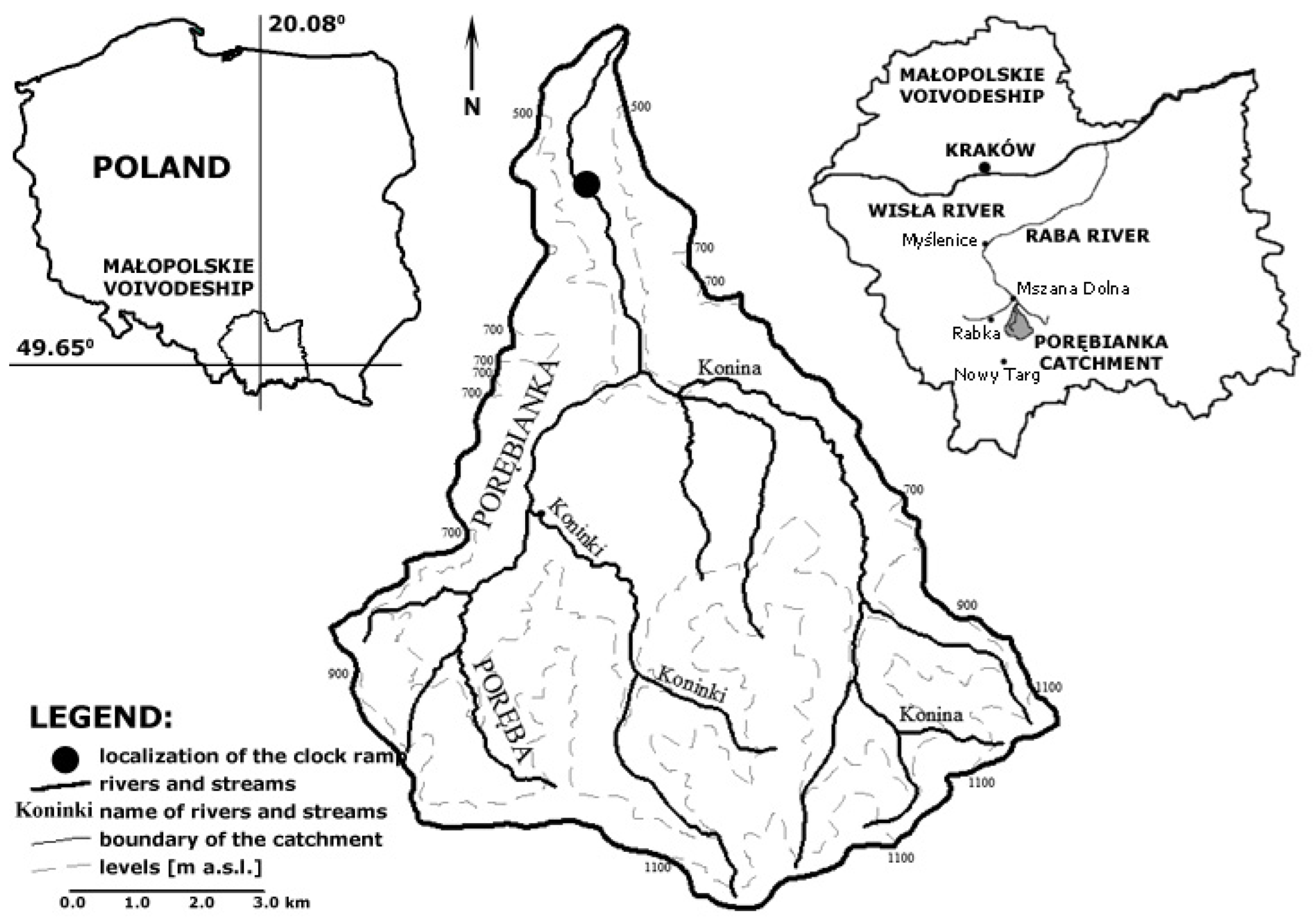
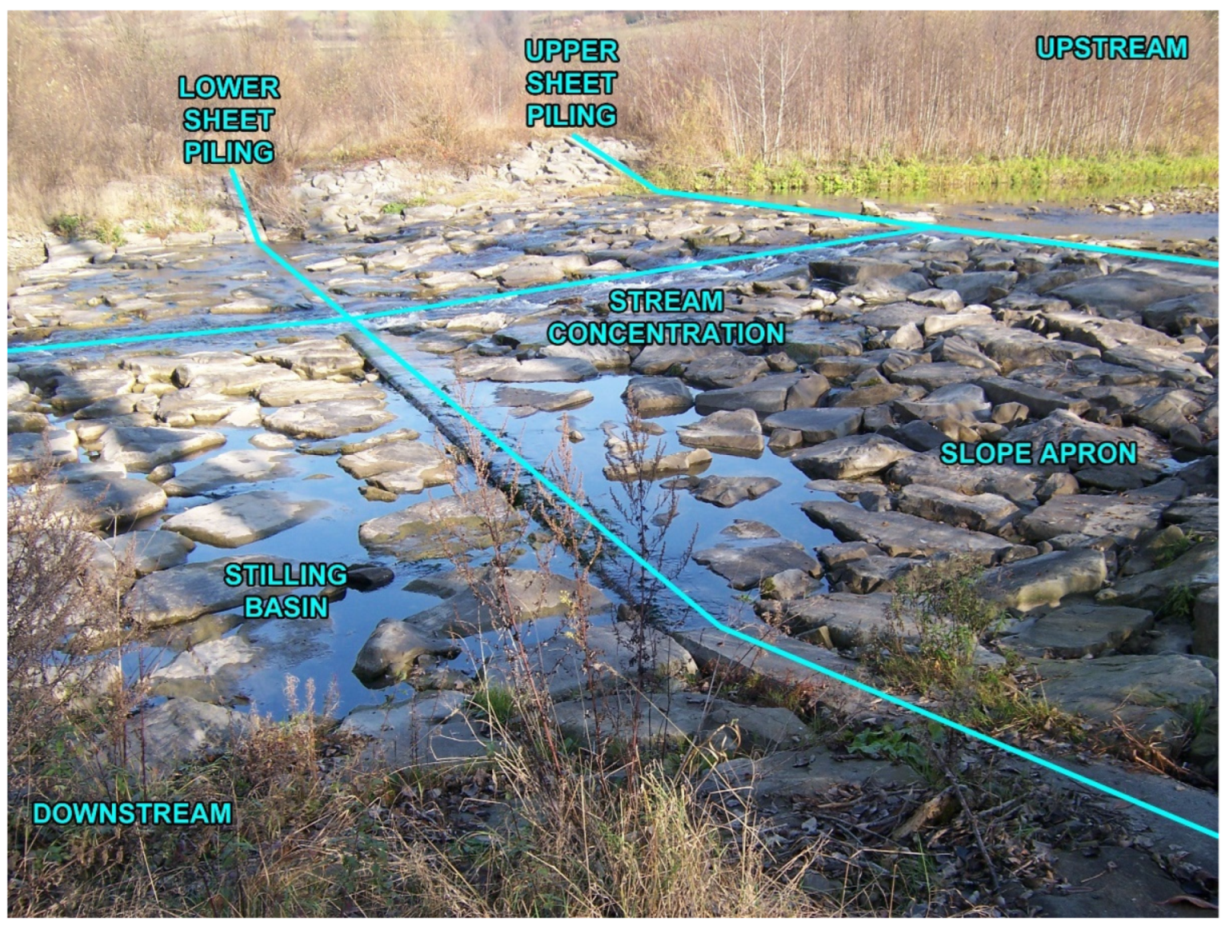
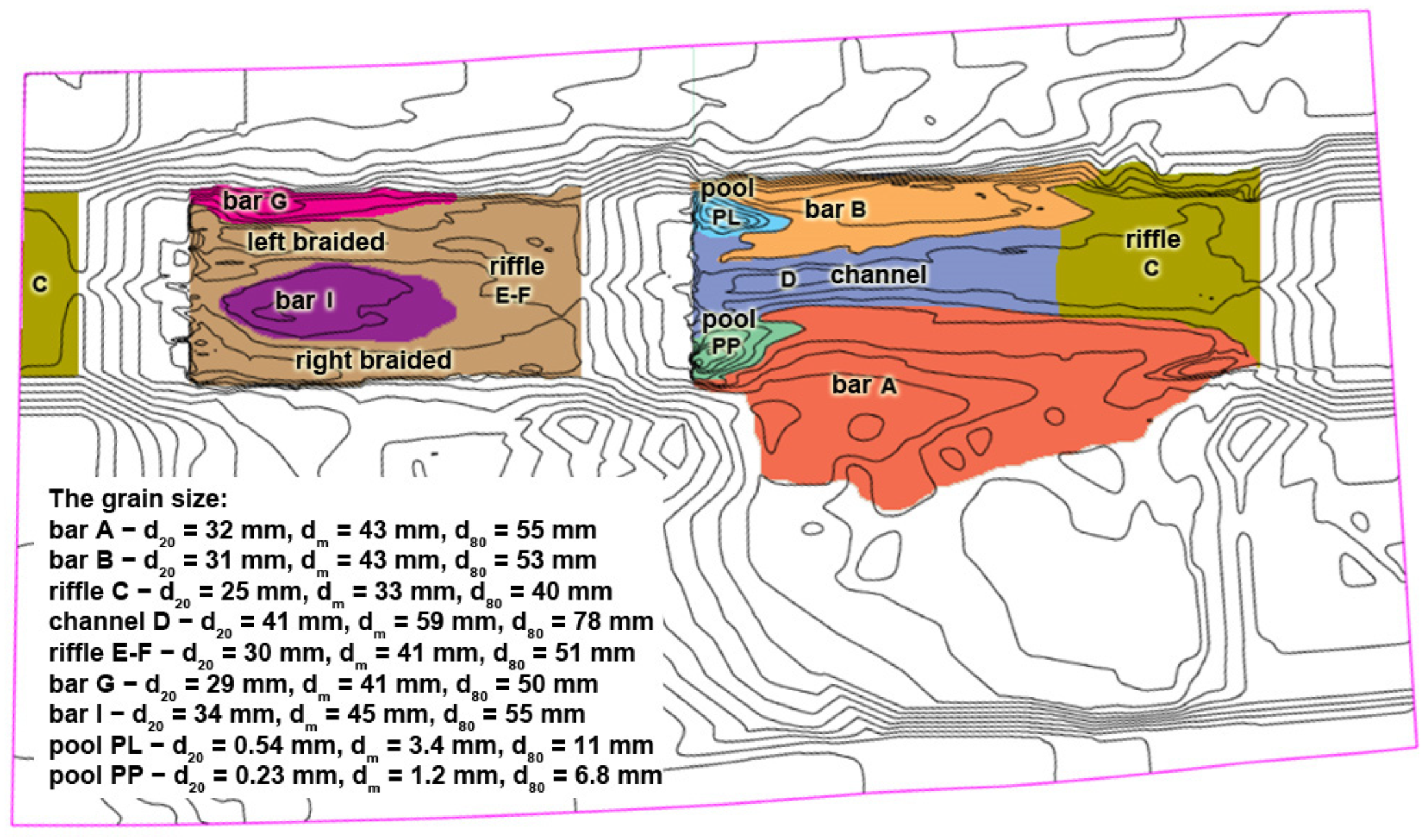

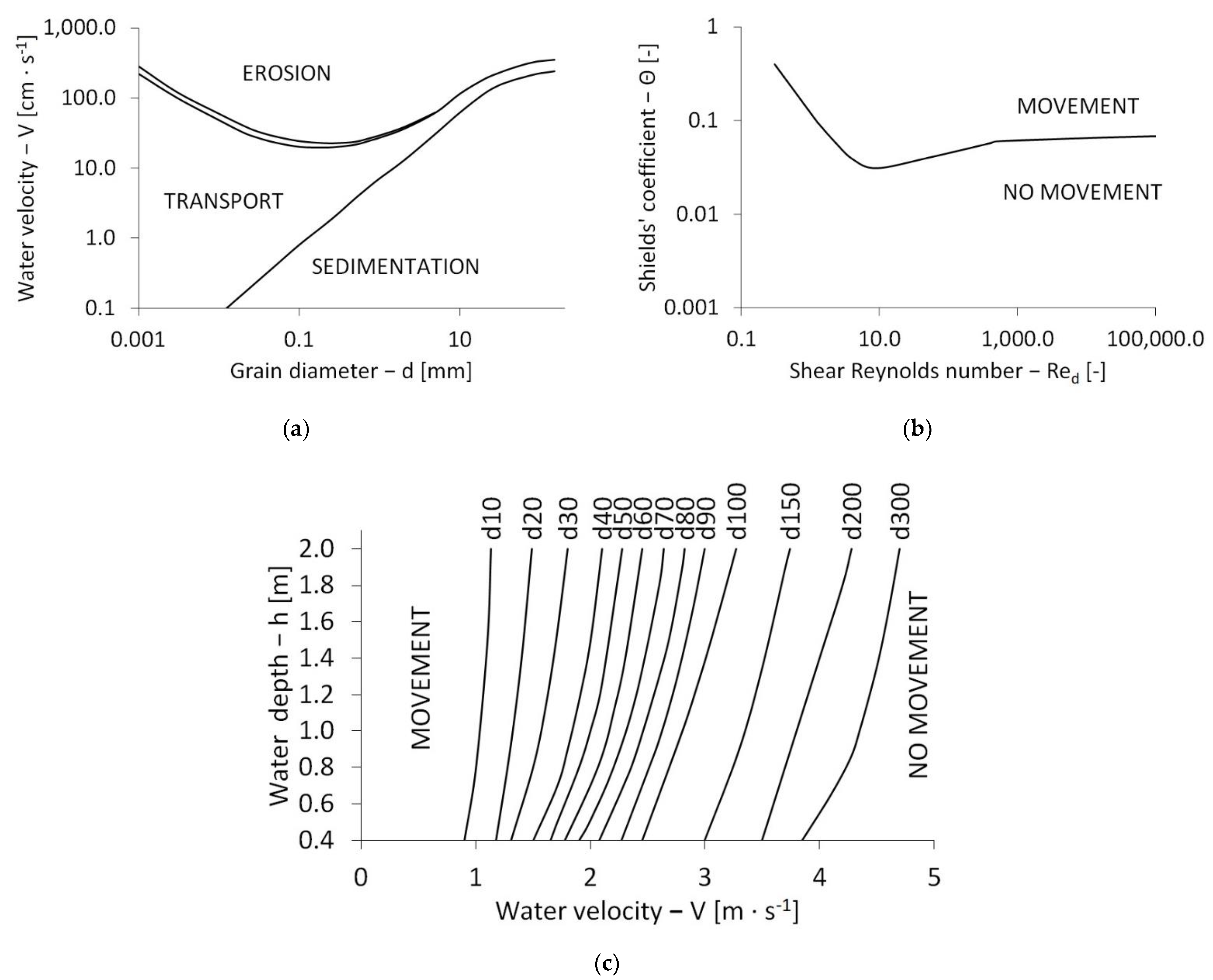
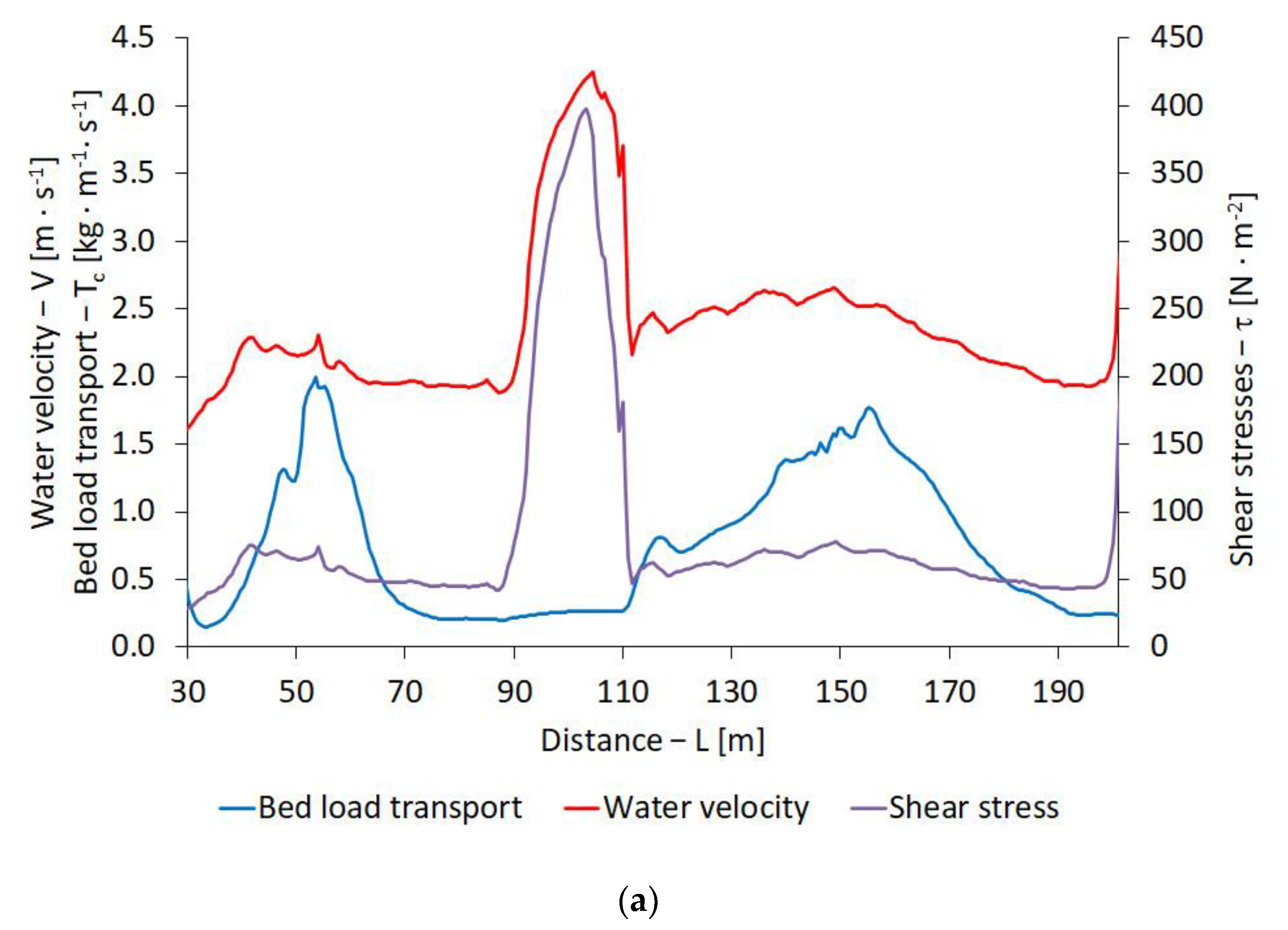
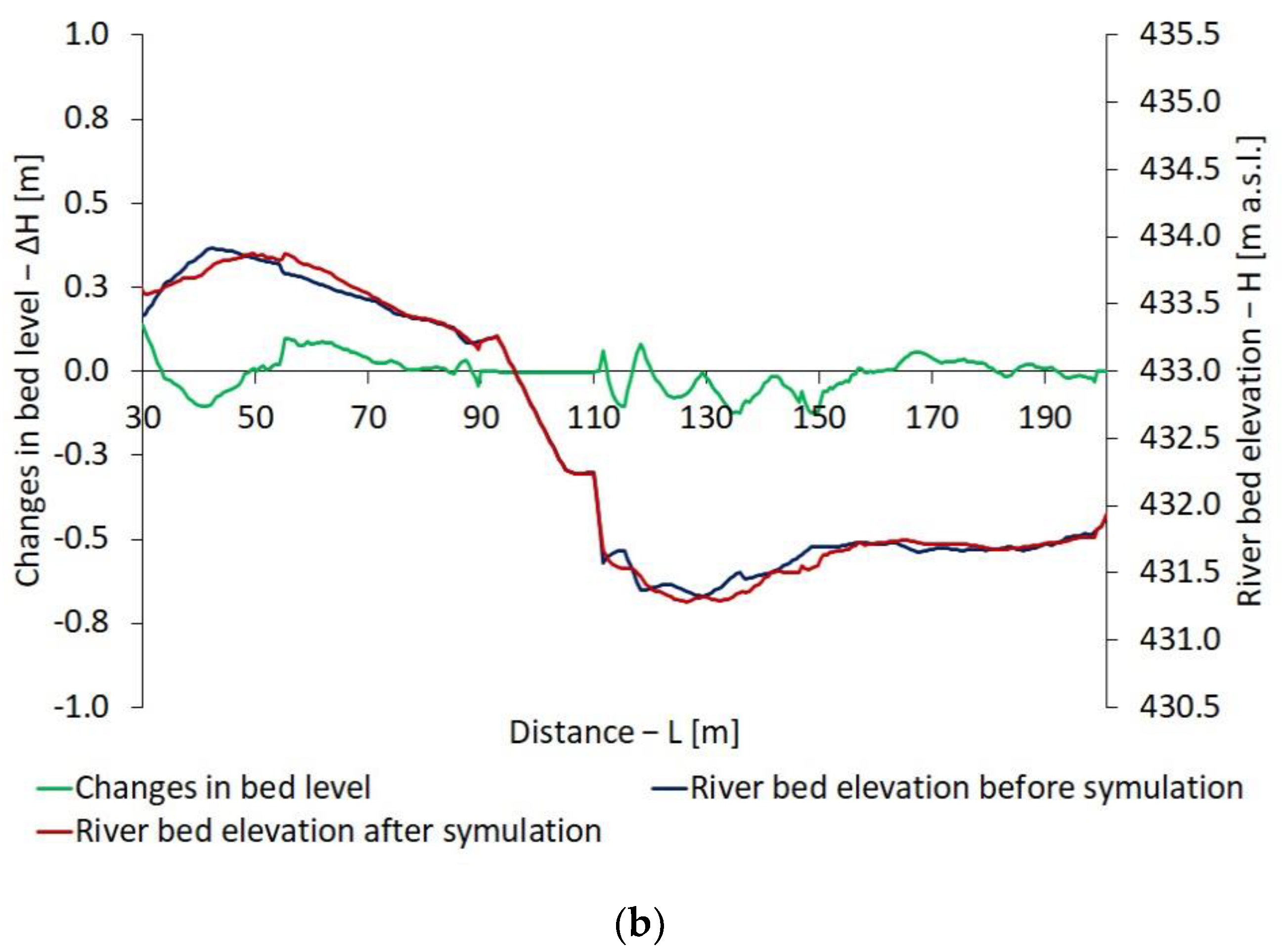
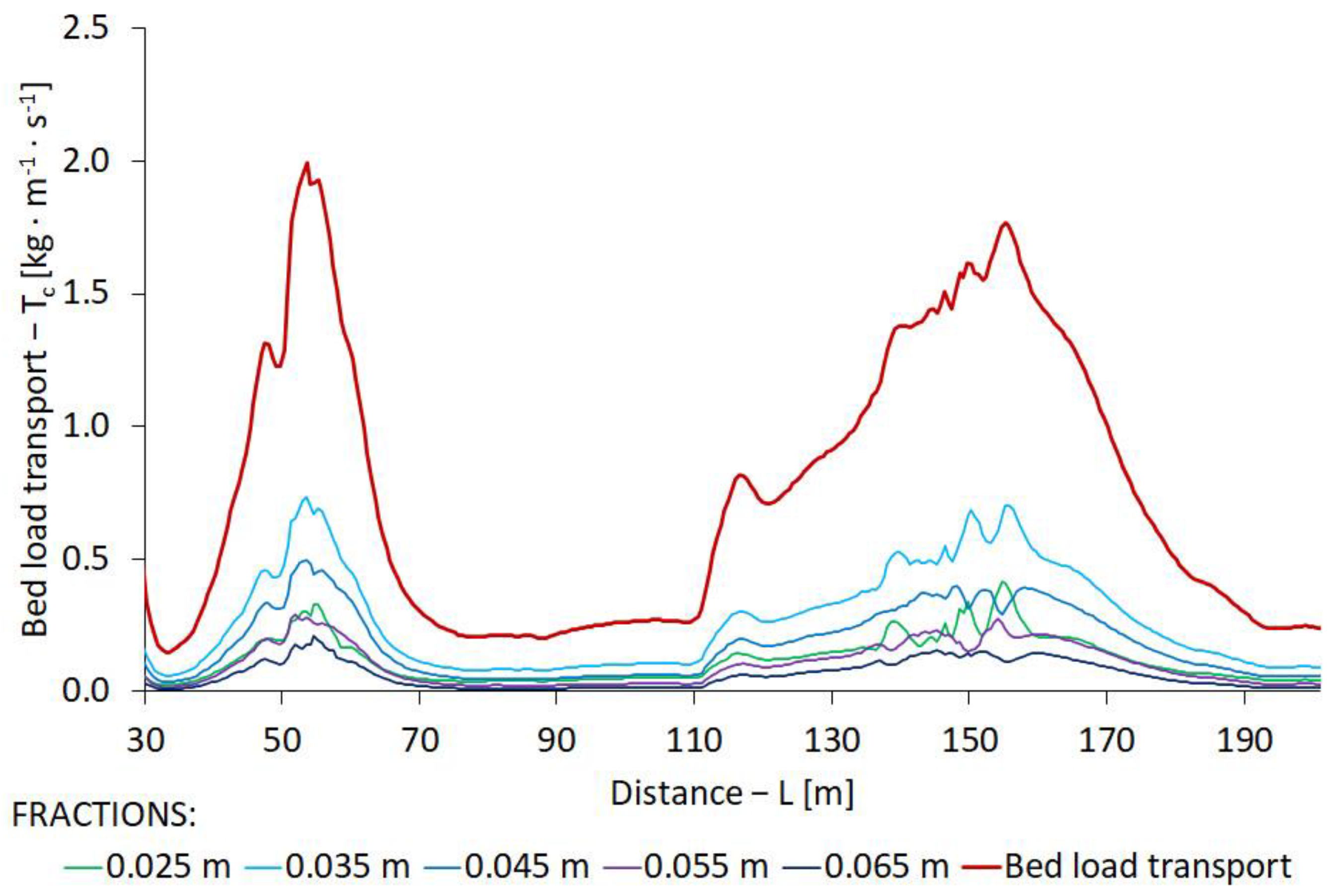

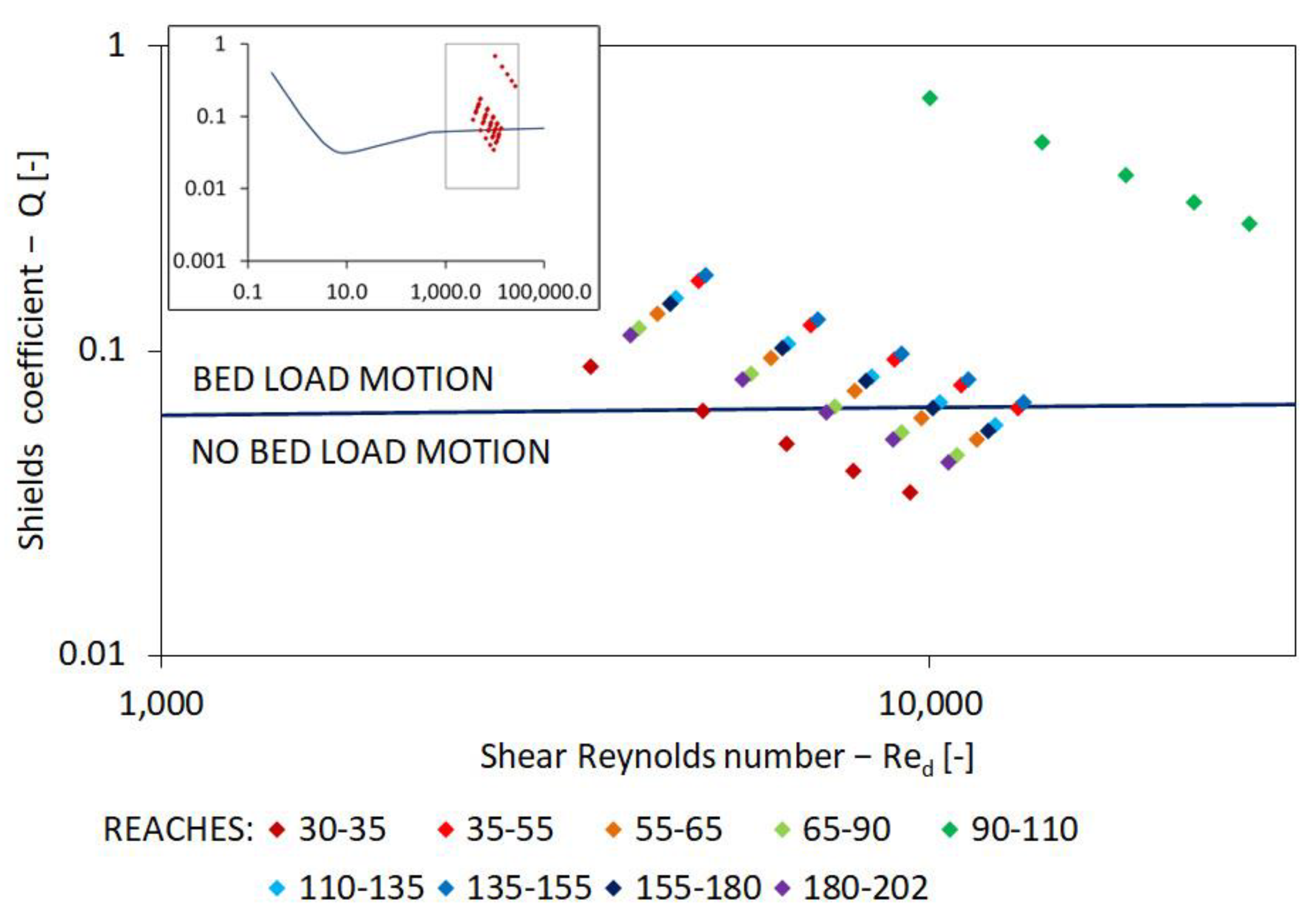
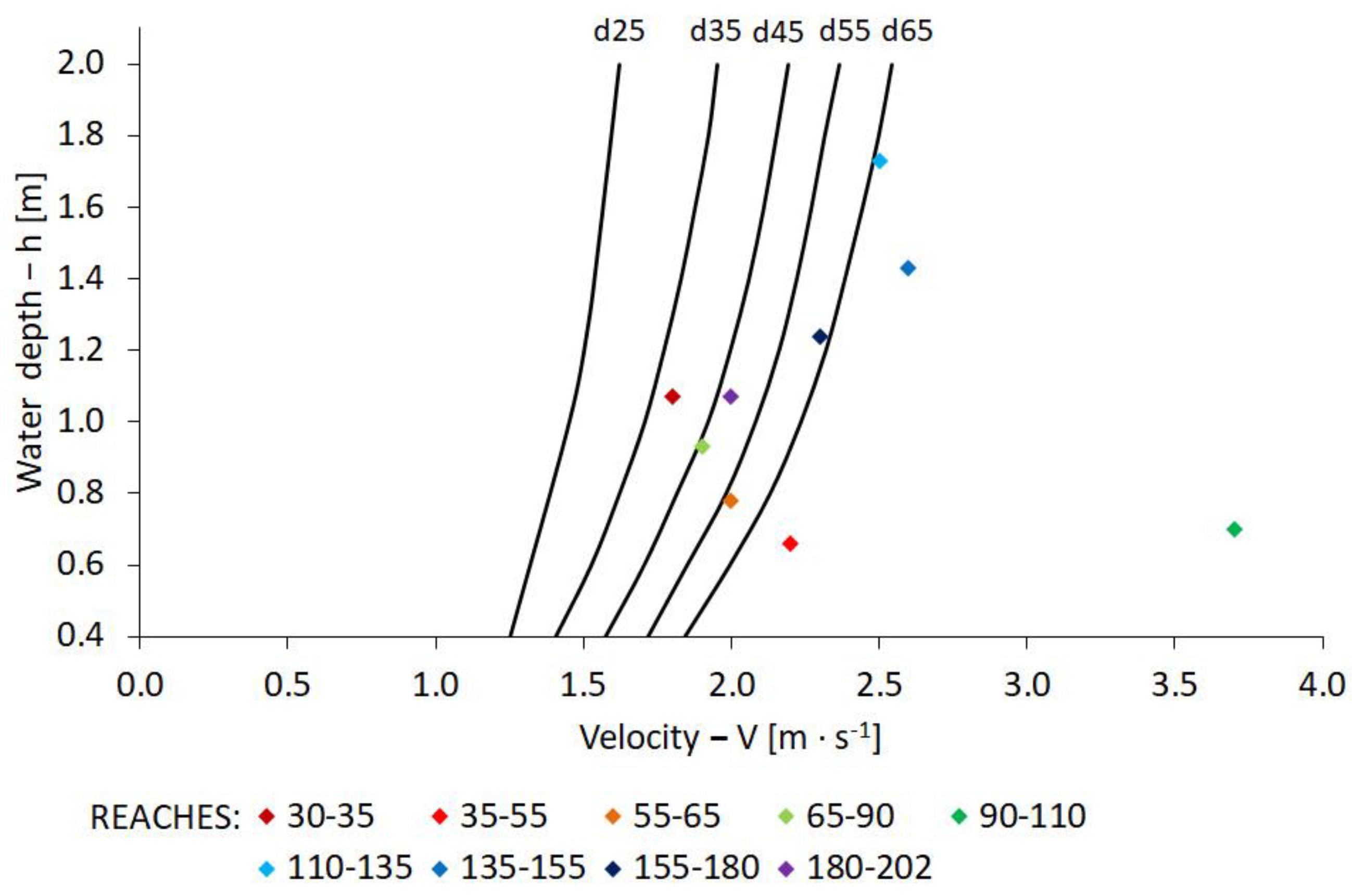

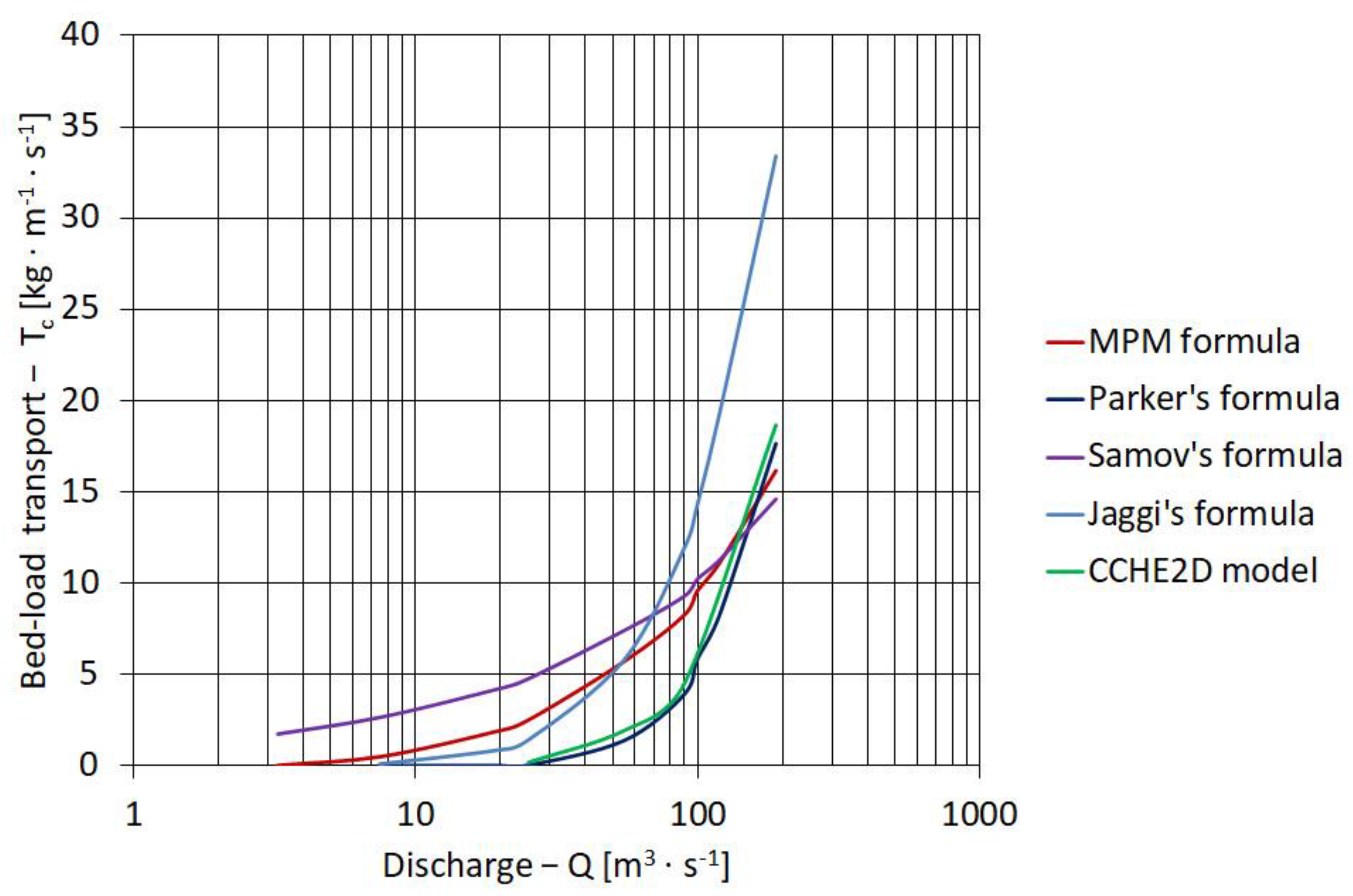

Publisher’s Note: MDPI stays neutral with regard to jurisdictional claims in published maps and institutional affiliations. |
© 2022 by the authors. Licensee MDPI, Basel, Switzerland. This article is an open access article distributed under the terms and conditions of the Creative Commons Attribution (CC BY) license (https://creativecommons.org/licenses/by/4.0/).
Share and Cite
Plesiński, K.; Radecki-Pawlik, A.; Kuboń, P.; Tatara, T.; Pachla, F.; Jurkowska, N. Bed Load Transport and Alternation of a Gravel-Bed River Morphology within a Vicinity of Block Ramp: Classical and Numerical Approach. Sustainability 2022, 14, 4665. https://doi.org/10.3390/su14084665
Plesiński K, Radecki-Pawlik A, Kuboń P, Tatara T, Pachla F, Jurkowska N. Bed Load Transport and Alternation of a Gravel-Bed River Morphology within a Vicinity of Block Ramp: Classical and Numerical Approach. Sustainability. 2022; 14(8):4665. https://doi.org/10.3390/su14084665
Chicago/Turabian StylePlesiński, Karol, Artur Radecki-Pawlik, Piotr Kuboń, Tadeusz Tatara, Filip Pachla, and Nadzieja Jurkowska. 2022. "Bed Load Transport and Alternation of a Gravel-Bed River Morphology within a Vicinity of Block Ramp: Classical and Numerical Approach" Sustainability 14, no. 8: 4665. https://doi.org/10.3390/su14084665
APA StylePlesiński, K., Radecki-Pawlik, A., Kuboń, P., Tatara, T., Pachla, F., & Jurkowska, N. (2022). Bed Load Transport and Alternation of a Gravel-Bed River Morphology within a Vicinity of Block Ramp: Classical and Numerical Approach. Sustainability, 14(8), 4665. https://doi.org/10.3390/su14084665







